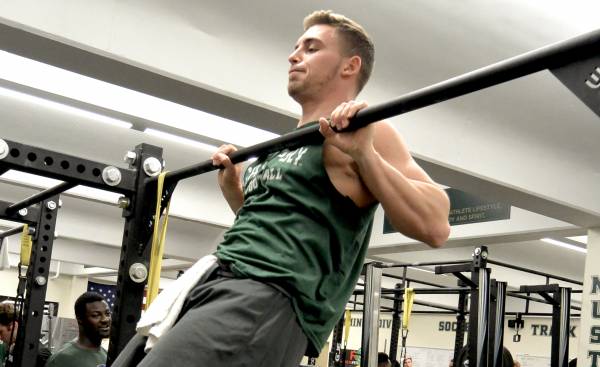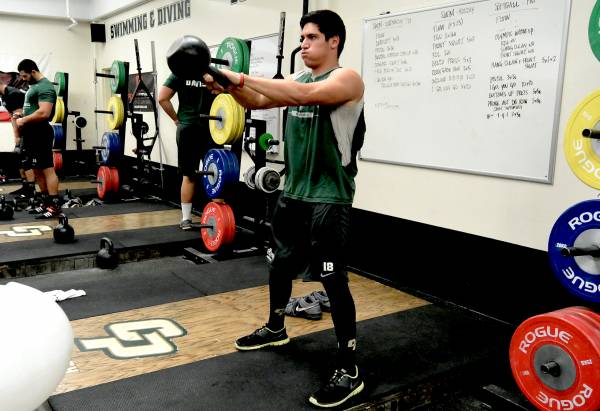I work as a college strength coach for over 500 student-athletes from 21 different sports. Below I have listed my top six training elements for these athletes. Regardless of his or her sport, each student performs these movements at least once a week. These movements are the foundation of all my training programs, and there are damn good reasons for that. Here are those reasons.
#6: Hip Flow
Movement-based, quasi-primal sequences have caught the eye of many coaches. They picked up even more traction when Conor McGregor included this work in his last training camp with Ido Portal before embarrassing Jose Aldo in UFC 194. Gone are the days of static stretching and dynamic warm ups. This new flow culture aims to warm and tune the nervous system, develop flexibility, and restore lost movement.
Identify bundles of general movement that restore motion through a variety of movement-based poses.
My assistant Chris White created the Cal Poly Hip Flow last fall for our track and field team. He coached it to each group, every day, at the beginning of every training session. Quickly we found the athletes began to show levels of restored motion in the basic lifts we’d been trying to correct for years. Beginning this winter quarter, every team opens each training session with this 5-6 minute warm up, and the payoff has been tremendous.
When putting together your flow, identify bundles of general movement that restore motion through different planes within a variety of movement-based poses. Chris White created our flow by watching video after video of Max Shanks’ five-minute flow (follow Max on Facebook – he posts variations every few days) and creating a mash-up between this and Z Health’s Neural Warm Up. Our hybrid flow emphasizes spinal mechanics, hip movements in all planes, and ankle mobility.
#5: Squat
In my shop, you are going to squat, and you should be able to do it with ease. Unfortunately, because of the pandemics of sitting and technology, our athletes have begun to devolve at an alarming pace. Gone are the days where a new freshman walks through my doors and can sit deep with posture. It’s a shit show, to put it mildly.
There are dozens of reasons you should squat. From strengthening the legs and hips to teaching full-body tension, the squat is the granddaddy of all movements. There are some less common aspects to why and how I teach the squat, including:
- Developing a more intimate relationship with the big toe (something our athletes have completely lost)
- Increasing flexibility
- Teaching athletes how to breathe for power
Whatever your reasons, make sure you are doing some variation of a squat.
#4: Romanian Deadlift
My first love is speed. It is not just the difference between winning or losing. In many cases, it’s the difference between embarrassing your opponent or not. Because of where I work, and particularly with the style of offensive attack we run here, my guys are undersized. I don’t have an offensive lineman over 6’3’’, and I have several wide outs and defensive backs under 160lb. We have to be fast to be competitive.
The Romanian deadlift (RDL) is the perfect exercise for anyone who needs to sprint in their sport. Hamstrings are critical for developing speed and power in running. Unfortunately, once a hamstring injury occurs, most athletes are never the same. They end up nursing a chronic hammy through the rest of their careers.
Because the hamstring decelerates the lower leg in sprint mechanics, the RDL is the perfect exercise to hammer the required eccentric strength. I’m a prison guard when it comes to teaching the RDL. I use the common technique cues, but also add some of those tricks you develop over time teaching this exercise. For example, try lifting your hip up towards the ceiling to increase the tension in the hamstring at both ends. Also, pry the knees slightly and you will add layers of hip stability as you move. It will also protect the lower back as you hinge.
#3: Pull Ups
The upper back is to the upper body as the hips are to the lower body. If you get your back strong, your entire upper body will benefit. The back is the foundation for pressing. It protects the shoulder in all motions and makes a huge difference for the elbows in any pulling motion. Lack of upper back development is one reason we see so many shoulder issues with young athletes.

Once you start demanding full and flexed reps, you will see improvement in all your upper body lifts.
Pull ups are your key to upper back strength, but only when performed correctly. And let me tell you, they are performed poorly in nearly every training facility I’ve ever been in. The two most critical errors I see in this exercise are:
- Not locking the scapulae down and together prior to pulling: If you are a big guy and you don’t secure your scaps before you begin pulling, your elbows will suffer because the biceps will become the primary mover. This is a fact. If you are smaller, you’ll develop some elbow inflammation.
- Incomplete reps: When did we decide that once the chin clears the bar the rep is complete? For most people, that’s about 60 degrees of potential range of motion that is left on the table. Try it without a bar. Flex your back as if doing a pull up, then pull your hands down to the place where only your chin would clear. Now finish the rep by pulling the elbows behind you. Can you feel the level of contraction you are getting now? Most of you are forfeiting this potential. The CrossFit world uses the term “chest to bar” pull up. In my world, those are just pull ups.
When you engage the muscles in your upper back from start to finish, you will realize your back is considerably weaker than you thought. Once you start demanding full and flexed reps, you will experience a tangible cascade of goodness in all your upper body lifts.
#2: Qigong, Tai Chi, Meditation, or Yoga
If you aren’t using one of these your program, you are missing out in a huge way. Most of you know I’m a Qigong guy, but participating in at least one of the above activities is critical if you want to get seriously strong. Let me explain why.
You’ve all seen the yin and yang symbol that represents balance. That balance is critical for health and wellness. Weight training of any kind is a yang activity. When you think of yang, think hot, male, aggressive, light, and the heavens. Qigong, Tai Chi, meditation, or yoga are yin activities. Yin is the direct opposite of yang – cool, female, passive, and dark. It is symbolized by the earth. Sleep, eating a cool diet (consisting of “cooling foods” like cucumber, spinach, apples, egg whites, yogurt, and cheese), and prayer all fall under the yin spectrum.
“Fifteen minutes a day of Qigong, Tai Chi, meditation, or yoga can add considerable levels of balance to your world.”
If you only do yang-based activities throughout your day, you’ll end up cooking yourself. You can’t live a life filled with yang activities and not consciously restore the balance. You don’t need to move to a monastery or ashram. Fifteen minutes a day of Qigong, Tai Chi, meditation, or yoga can add considerable levels of balance to your world.
Even if you don’t fully understand the whole yin/yang thing, know that if this balance is present, everything in your body upgrades. Your recovery improves, your stress levels diminish, your digestion gets better, your cognition gets sharper. Hell, even your performance in the bedroom becomes more potent. So get some quiet in your day. Find an instructor or meditation CD, join a Tai Chi class, or simply find a tree and sit underneath it.
I provide a daily Qigong recharge for all of my athletes who choose to take part. Those who participate report a greater feeling of well-being, restful sleep, and calmness. We are able to reduce their stress and help restore this balance in their lives and performance.
#1: Kettlebell Swing
What were you expecting? Bench press? No way. The kettlebell swing is my all-time favorite exercise in any and all of my programs. Every single one of my athletes swings or does a swinging variation at each training session.
The swing is the jack-of-all-trades exercise for athletes. Your athlete wants to become faster? Check. He needs to lose weight? You have it. You have an athlete who wants to jump higher? Got it. Perhaps you need deeper levels of cardiovascular fitness? On it. How about power development and quick twitch? You bet.

Every single one of my athletes swings or does a swinging variation at each training session.
However, to achieve these significant and varied goals you need a seasoned instructor who understands tempo, intensity, rhythm, and technique. My athletes have hardstyle RKC swings shoved down their throats daily. I tell all my athletes, “I can win games with swings alone” – and I mean it. We will win and die by the swing.
Put These to Use
I’ve spent a lot of years coaching. I’ve made some great decisions and I’ve made complete bonehead decisions. Don’t allow yourself to become so specialized or sport-specific that your program gets away from what really matters.
I’ve noticed if I move away from any from the focused six, problems surface or my athletes take longer to prepare for competition. Add them into your coaching and you’ll see why.
More like this:
- The 10 Commandments of the Kettlebell Swing
- Squat Therapy: 4 Drills for a Better Squat
- Successful Pull Ups for Beginners: Say No to Bands
- New on Breaking Muscle Today
Photos courtesy of Chris Holder.






